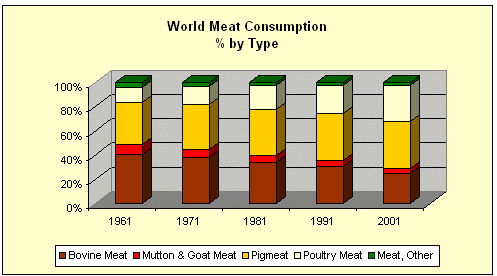Demand for Ostrich Meat and Export Regulations
The World Ostrich Association receives many requests asking about the demand for Ostrich Meat and Export regulations. The following represents the Associations response to these questions.
Meat Demand
Currently the demand for ostrich meat is far in excess of supply. Current world production of Ostrich meat is only 12,000 to 15,000 metric tonnes as the industry has not yet made a full transition from breeder markets to commercial production. Around 60% of this production is in South Africa. The remainder of the production is fragmented.
Figure 1 shows the production growth by specie since 1961. Figure 2 demonstrates the percentage of the total of each specie and shows very clearly the contribution of Pork and Poultry in this growth and the loss of market share experienced by the red meats Beef, Veal, Lamb and Mutton over the period. Some of this loss of market share can be attributed to the advice to eat low fat meats; some of the loss of market share can be attributed to the lower feed efficiency of ruminants.
Ostrich produce a low fat, red meat and proven, where reared correctly to be the most feed efficient red meat specie, with excellent feed conversion. This means that Ostrich can contribute to the increased demand for meat whilst utilising fewer resources than competitive specie to produce that meat.

Figure 1- World Meat Consumption
Figure 2 clearly shows that the bulk of the increased meat production over the past few decades has come from the improved efficiencies in the production of poultry and pork. Grain rations are the basis of Poultry and Pig rations. Ostrich produce their meat utilising around 40% Lucerne/Alfalfa in their rations, the implication of this being that Lucerne, as a legume, fixes nitrogen in the soil so when used in crop rotation reduces the need for artificial fertilisers to grow grain.
All of these factors combine to provide significant opportunities for Ostrich Meat in the market today and will do so increasingly into the future. The efficiencies of Ostrich production can enable it to win back lost red meat market share and enable the consumer to have greater variety.

Figure 2 - Meat Market Share by Specie
The additional meat production is quantified at 130 million metric tonnes; 14% from Beef, Veal, Lamb and Mutton, 43% from Pigmeat, 40% from poultry and 3% from other specie, which will include Goat, Fish and other alternative meats including Ostrich. Note the reducing market share of the red meats. It requires 28 million Ostrich Slaughter birds producing 45 kilograms of meat to produce just 1% of that additional 130 million metric tonnes required.
The above clearly demonstrates the potential size of the market for ostrich meat is very significant.
Modern systems of production are required to optimise the production potential of Ostrich to enable the industry to deliver. Systems that ensure producers move away from the current very low productivity, high levels of chick mortality, low meat yields and delayed slaughter are essential to be able to meet this challenge.
Export Regulations
The Association receives a number of enquiries about export regulations for meat to perceived existing markets. The above demonstrates the market potential, but illustrates there are no major markets at this time as there is no meaningful commercial production.
The associationís advice is to first secure a local market before attempting to develop an export market. The reason given for wanting to export is always because there is no market yet in our country.† The above demonstrates that the market for Ostrich meat is new in every country because there is no meaningful production.
The main reason for advising local market development is because disease outbreaks result in a total ban on exports from affected countries. Avian Influenza and New Castle Disease are two examples that impact on Ostrich. Such disease outbreaks in Poultry in the exporting country may result in a ban on the export of ostrich meat even if the Ostrich flock is free from these diseases.
There are no standard protocols for all countries. The export regulations vary from country to country depending on the demands of the importing country and the standard of the state veterinary services in the exporting country. Also of influence is if the exporting country is avian influenza and/or New Castle Disease Free status, or if these diseases are endemic within the country. Each exporting countryís state veterinary department will need to establish the protocols with the importing country on an individual basis.
Copyright © of the World Ostrich Association, All Rights Reserved |